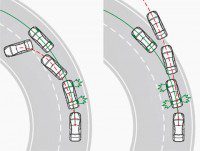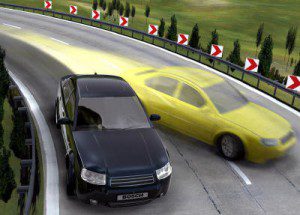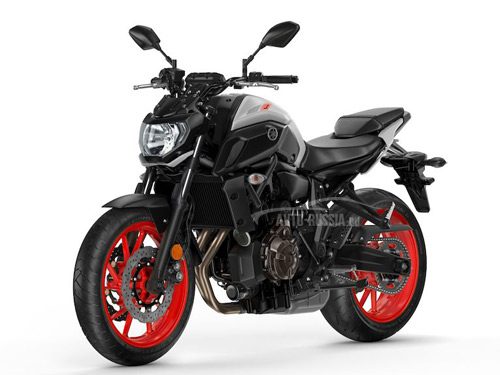
Electronic stabilization systems (ESP, AHS, DSC, PSM, VDC, VSC)
 These systems ensure that the vehicle behaves safely in critical situations, especially when cornering. During the movement, the systems evaluate several indicators, such as the speed or rotation of the steering wheel, and in the event of a risk of skidding, the systems can return the car to its original direction by braking individual wheels. In more expensive vehicles, stability control systems also feature an active chassis that adapts to the driver's surface and driving style and further contributes to driving safety. Most cars use a marking system on their vehicles. ESP (Mercedes-Benz, Skoda, VW, Peugeot and others). With marking AHS (Active processing system) used by Chevrolet in their vehicles, DSC (Dynamic security control)BMW, PSM (Porsche Stability Management System), V DC (Vehicle dynamics control) is installed on Subaru cars, VSC (Vehicle stability control) is also installed on Subaru as well as Lexus vehicles.
These systems ensure that the vehicle behaves safely in critical situations, especially when cornering. During the movement, the systems evaluate several indicators, such as the speed or rotation of the steering wheel, and in the event of a risk of skidding, the systems can return the car to its original direction by braking individual wheels. In more expensive vehicles, stability control systems also feature an active chassis that adapts to the driver's surface and driving style and further contributes to driving safety. Most cars use a marking system on their vehicles. ESP (Mercedes-Benz, Skoda, VW, Peugeot and others). With marking AHS (Active processing system) used by Chevrolet in their vehicles, DSC (Dynamic security control)BMW, PSM (Porsche Stability Management System), V DC (Vehicle dynamics control) is installed on Subaru cars, VSC (Vehicle stability control) is also installed on Subaru as well as Lexus vehicles.
The abbreviation ESP comes from English Electronic stability program and stands for electronic stabilization program. From the name itself, it is clear that this is a representative of electronic driver assistants in terms of driving stability. The discovery and subsequent implementation of ESP was a breakthrough in the automotive industry. A similar situation once happened with the introduction of the ABS. ESP helps the inexperienced and highly experienced driver cope with some of the critical situations that may arise while driving. A number of sensors in the car record current driving data. This data is compared via the control unit with the calculated data for the correct driving mode. When a difference is detected, ESP is automatically activated and stabilizes the vehicle. ESP uses other electronic chassis systems for its function. The most important electronic workers include the ABS anti-lock braking system, anti-skid systems (ASR, TCS and others) and advice on the operation of the necessary ESP sensors.
The system was developed by engineers from Bosch and Mercedes. The first car to be equipped with ESP was the S 1995 luxury coupe (C 600) in March 140. A few months later, the system also made its way to the classic S-Class (W 140) and SL Roadster (R 129). The price of this system was so high that at first the system was only standard in combination with the top-end 6,0 V12 twelve-cylinder engine, for other ESP engines it was offered only for a hefty surcharge. The real boom in ESP was due to seemingly little things and, in a way, coincidence. In 1997, Swedish journalists conducted a stability test for the then novelty, which was the Mercedes A. To the great surprise of everyone present, Mercedes A could not cope with the so-called moose test. This marked the beginning of a business that forced the manufacturers to suspend production for a short time. The efforts of the technicians and designers at the Stuttgart Automobile Plant to find the right solution to the problem have been crowned with success. Based on numerous tests, ESP became a standard part of Mercedes A. This, in turn, meant an increase in the production of this system from the expected tens of thousands to hundreds of thousands, and more affordable prices could be achieved. ESP has paved the way for use in medium and small vehicles. The birth of ESP was a real revolution in the field of safe driving, and today it is relatively widespread not only thanks to Mercedes-Benz. The existence of ESP, which is developing and is currently its largest manufacturer, contributed a lot to the existence of ESP.
In most electronic systems, the brain is the electronic control unit, and this is not the case with ESP. The task of the control unit is to compare the actual values from the sensors with the calculated values while driving. The required direction is determined by the angle of rotation and the speed of rotation of the wheels. The actual driving conditions are calculated based on the lateral acceleration and the rotation of the vehicle around its vertical axis. If a deviation from the calculated values is detected, the stabilization process is activated. ESP operation regulates engine torque and affects the braking system of one or more wheels, thereby eliminating unwanted vehicle movement. ESP can correct understeer and oversteer when cornering. Vehicle understeer is corrected by braking the rear inner wheel. Oversteer is corrected by braking the front outer wheel. When braking a given wheel, braking forces are generated on that wheel during stabilization. According to a simple law of physics, these braking forces create torque around the vehicle's vertical axis. The resulting torque always counteracts unwanted movement and thus returns the vehicle in the desired direction when cornering. It also turns the car in the right direction when it is not turning. An example of ESP operation is fast cornering when the front axle quickly exits the corner. ESP first reduces engine torque. If this action is not enough, the rear inner wheel is braked. The stabilization process continues until the tendency to skid is reduced.
ESP is based on a control unit that is common to ABS and other electronic systems such as the EBV / EBD brake force distributor, engine torque regulator (MSR) and anti-skid systems (EDS, ASR and TCS). The control unit processes data 143 times per second, that is, every 7 milliseconds, which is almost 30 times faster than that of a human. ESP requires a number of sensors to operate, such as:
- brake detection sensor (informs the control unit whose driver is braking),
- speed sensors for individual wheels,
- steering wheel angle sensor (determines the required direction of travel),
- lateral acceleration sensor (registers the magnitude of the acting lateral forces, such as the centrifugal force on the curve),
- a vehicle rotation sensor around the vertical axis (to assess the rotation of the vehicle around the vertical axis and determine the current state of movement),
- brake pressure sensor (determines the current pressure in the brake system, from which the braking forces and, therefore, the longitudinal forces acting on the vehicle can be calculated),
- longitudinal acceleration sensor (only for four-wheel drive vehicles).
In addition, the braking system requires an additional pressure device that applies pressure when the driver is not braking. The hydraulic unit distributes the brake pressure to the brake wheels. The brake light switch is designed to turn on the brake lights if the driver does not brake when the ESP system is on. ESP can sometimes be deactivated with a button on the dashboard, which is convenient, for example, when driving with snow chains. Turning off or on the system is indicated by a lit indicator on the instrument panel.
ESP allows you to somewhat push the boundaries of the laws of physics and thus increase active safety. If all cars were equipped with ESP, about a tenth of accidents could be avoided. The system constantly checks for stability if not turned off. Thus, the driver has a greater sense of safety, especially on icy and snowy roads. Since ESP corrects the direction of travel in the desired direction and compensates for deviations caused by skidding, it significantly reduces the risk of accidents in critical situations. However, it should be emphasized in one breath that even the most modern ESP will not save a reckless driver who does not follow the laws of physics.
Since ESP is a trademark of BOSCH and Mercedes, other manufacturers either use the Bosch system and the ESP name, or have developed their own system and use a different (own) acronym.
Acura–Honda: Vehicle Stability Control (VSA)
Alfa Romeo: Dynamic Vehicle Control (VDC)
Audi: Electronic Stability Program (ESP)
Bentley: Electronic Stability Program (ESP)
BMW: vrátane Dynamic Traction Control DSC
Bugatti: Electronic Stability Program (ESP)
Buick: StabiliTrak
Cadillac: StabiliTrak and Active Front Steering (AFS)
Chery Car: Electronic Stability Program
Chevrolet: StabiliTrak; Active handling (Lin Corvette)
Chrysler: Electronic Stability Program (ESP)
Citroën: Electronic Stability Program (ESP)
Dodge: Electronic Stability Program (ESP)
Daimler: Electronic Stability Program (ESP)
Fiat: Electronic Stability Program (ESP) and Vehicle Dynamic Control (VDC)
Ferrari: Established Control (CST)
Ford: AdvanceTrac with Roll Over Stability Control (RSC), Interactive Vehicle Dynamics (IVD), Electronic Stability Program (ESP) and Dynamic Stability Control (DSC)
General Motors: StabiliTrak
Holden: Electronic Stability Program (ESP)
Hyundai: Electronic Stability Program (ESP), Electronic Stability Control (ESC), Vehicle Stability Assist (VSA)
Infiniti: Vehicle Dynamic Control (VDC)
Jaguar: Dynamic Stability Control (DSC)
Jeep: Electronic Stability Program (ESP)
Kia: Electronic Stability Control (ESC) and Electronic Stability Program (ESP)
Lamborghini: Electronic Stability Program (ESP)
Land Rover: Dynamic Stability Control (DSC)
Lexus: Vehicle Dynamics Integrated Management (VDIM) and Vehicle Stability Control (VSC)
Lincoln: AdvanceTrac
Maserati: Maserati Stability Program (MSP)
Mazda: Dynamic Stability Control (DSC), vrátane Dynamic Traction Control
Mercedes-Benz: Electronic Stability Program (ESP)
Mercury: AdvanceTrac
MINI: Dynamic Stability Control
Mitsubishi: MULTI-MODE Active Stability Control and Traction Control a Active Stability Control (ASC)
Nissan: Vehicle Dynamic Control (VDC)
Oldsmobile: Precision Control System (PCS)
Opel: Electronic Stability Program (ESP)
Peugeot: Electronic Stability Program (ESP)
Pontiak: Stabili Trak
Porsche: Porsche Stability Control (PSM)
Proton: electronic stabilization program
Renault: Electronic Stability Program (ESP)
Rover Group: Dynamic Stability Control (DSC)
Saab: Electronic Stability Program (ESP)
Saturn: StabiliTrak
Scania: Electronic Stability Program (ESP)
SEAT: Electronic Stability Program (ESP)
Škoda: Electronic Stability Program (ESP)
Smart: Electronic Stability Program (ESP)
Subaru: Vehicle Dynamics Control (VDC)
Suzuki: Electronic Stability Program (ESP)
Toyota: Vehicle Dynamics Integrated Management (VDIM) and Vehicle Stability Control (VSC)
Vauxhall: Electronic Stability Program (ESP)
Volvo: Dynamic Stability and Traction Control (DSTC)
Volkswagen: Electronic Stability Program (ESP)
